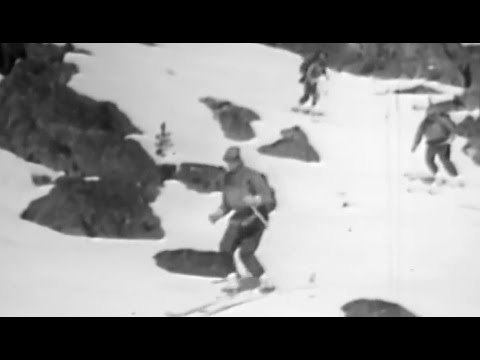Outdoor Recreation, Camping, Survival playlist:
US Army Training Film playlist:
more at
“SAFETY PRECAUTIONS IN CONNECTION WITH EXCESSIVE SPEED AND FAULTY ADJUSTMENTS–REMEDIES FOR OVER-HEATING, SUNBURN AND SNOWBLINDNESS.”
US Army training film TF7-680
Reupload of a previously uploaded film, in one piece instead of multiple parts, and with improved video & sound.
Public domain film from the US National Archives, slightly cropped to remove uneven edges, with the aspect ratio corrected, and one-pass brightness-contrast-color correction & mild video noise reduction applied.
The soundtrack was also processed with volume normalization, noise reduction, clipping reduction, and/or equalization (the resulting sound, though not perfect, is far less noisy than the original).
Cross-country skiing (commonly abbreviated XC skiing) is a winter sport in which participants propel themselves across snow-covered terrain using skis and poles. It is popular in many places with large snowfields, primarily Northern Europe, Canada, and Alaska.
Cross-country skiing is part of the Nordic skiing sport family, which also includes ski jumping, and a combination sport of cross-country skiing and ski jumping called Nordic combined. Free-technique cross-country skiing is also the method of locomotion in the combination sport of Biathlon, which adds rifle marksmanship to skiing. Another combination sport is ski-orienteering, which adds the skill of map navigation along snow trails and tracks.
Related sports are backcountry skiing and Telemark skiing. The ski touring article provides an overview of different ski styles and techniques…
History
Cross-country skiing originated in Fennoscandian countries in prehistoric times. It was still widely practiced in the 19th century as a way of moving from place to place in winter. Elk, deer and other animals were hunted by skiing. Nowadays many people in countries with strong cross-country skiing traditions — like Norway, Sweden, Finland, Estonia and Latvia — have used or regularly use skis.
By contrast skiing is relatively new in North America and was introduced by Norwegian and Swedish immigrants in the 1850s. Snowshoe Thompson is widely credited for introducing the sport to California in the USA. In Canada pioneers included Aldolf Olsen, Sigurd and Hans Lockeberg and Jackrabbit Johannsen.
In Canada, although Johannsen never claimed to be the first skier in Canada, he had a major role in stimulating an interest in the sport. He organized races, officiated events, and served as a guide, coach, and consultant for numerous skiing organizations, many of which he helped to found. An enthusiastic teacher, he helped coach Canada’s Olympic team in 1932. At the age of 55, he shocked his Canadian Olympic pupils as he accompanied the team step by step through its rigorous training schedule—and still he had energy to spare. This was, however, still quite far from being the twilight of Jackrabbit’s incredible skiing career, as he didn’t ski his last official race until the age of 75, and still glided through the snowy woods on a daily basis well past the age of 100.
This form of skiing has been used by explorers as a means of transport, and all Nordic armies have ski-trained infantry for winter operations. Skis gave important mobility to the Finnish army during the Winter War and allowed the small groups of Finns to beat large armies of Russians. Similar tactics that utilize skis have been used in many times by the Finns and Karelians in the past. Pre-modern skiing troops were armed with crossbows and ski poles which had a spearhead on the other end.
Traditionally, all of the equipment was made of natural materials: wooden skis and bamboo poles with leather hand straps. Footwear was usually sturdy leather boots with thick soles. Bindings evolved from simple straps made of twisted wood-based thread, to the so-called Kandahar binding with the fastening of both the boot’s front and back, to the ‘Rat Trap’ front-only binding, which is today known as the Nordic norm, and has evolved in various modern bindings…

